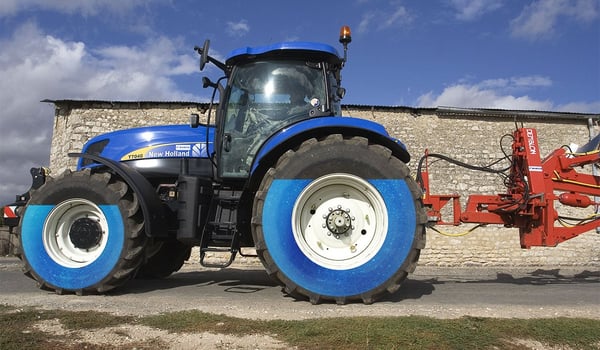BRIDGESTONE EUROPE NV/SA
AG Department
Kleine Kloosterstraat 10
1932 Zaventem
Belgium
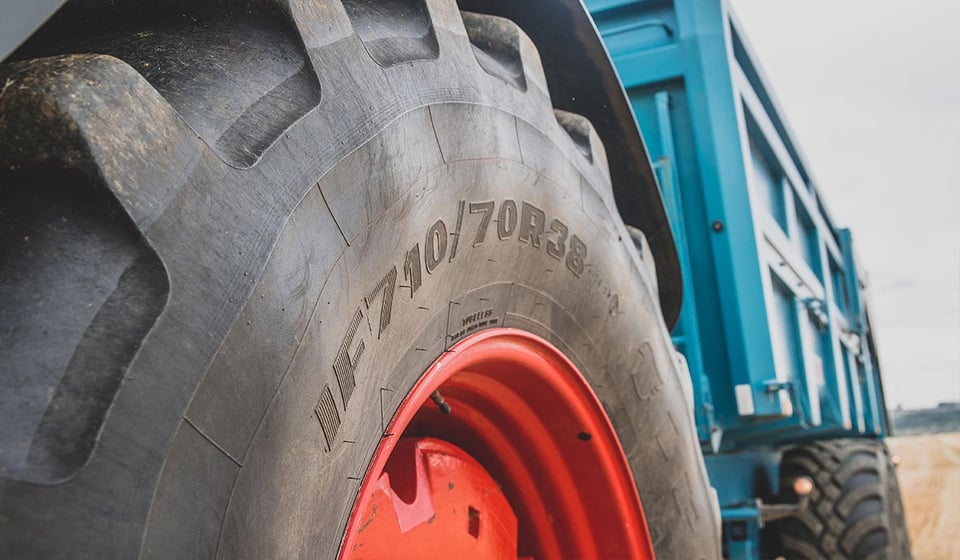
Authored by: Tractor tyre expert | 20 January 2021
It's often when the time comes to change your tractor tyres and choose a new model, that the markings and all the numbers on the sidewalls become important.
However, when you fully understand these figures you can improve your tractor’s capacity, for example increasing the maximum load or improving traction… and a change in tyre can also be a chance to boost your machine’s productivity.
However, to make the right choice, it is essential to fully understand all the markings on the sidewalls, each of which is significant.
Here is a detailed glossary to help you understand these markings.
Tyres themselves have evolved over time, and the markings with them. Depending on the manufacturers or the geographical area, these markings can differ greatly, while often describing the same things.
The information on tyres indicates the range, size, model, and the casing structure, Radial or Diagonal. There are different tyres for different machines and different uses.
To clarify the markings on tractor tyres, 50 years ago, a European group implemented the ETRTO norm (European Tyre and Rim Technical Organisation) whose aim is to simplify and standardise the sizes of farming tyres.
Despite the systematic integration of this norm, there are still tyres in circulation with the old markings, or from other regions in the world where this norm is not applied.
Generally indicated in inches, the old markings on tractor tyres are displayed as a string of numbers with a letter or a dash in the middle, as shown in the following examples:
The majority of farming tyres sold in Europe today carry the European ETRTO markings and must also include the code: E (E3 - E4 - etc.).
It becomes mandatory to have ‘E’ marking on tyres due to changes in EU Vehicle Registration method for original equipment manufacturers, which applies to Agricultural and Forestry vehicles from January 2018.
Number can vary by tyre manufacturer: this depends upon which approved homologation body is used by which tyre manufacture. Bridgestone and Firestone tyres, made in our European factory at Puente Sans Miguel in Spain, are homologated by RDW in the Netherlands, so in this case it will be 4.

Before replacing your old farming tyres, you must understand their measurements to be sure to find the equivalent size with the new markings or to improve your tyres and increase the capacity of your tractor.
Although the ETRTO norm has existed since 1964, you can still find tyres with the old markings on non-European tyres or on old tyres used on trailers or other farm vehicle:
The new ETRTO markings provide more precise indications on farming tyres than the old markings, as the height of the sidewall is now indicated systematically.
This is an extremely important indication, as the smaller the aspect ratio, the greater the volume of air the tyre can hold: so it can carry a heavier load and increase your tractor’s load capacity.
To switch from a series to another, you need to use the tyre correspondence table. The SRI (Speed Radius Index) groups all tyres sizes with similar diameters.
Any dimensional transformation requires a lead lag calculation, made by an expert.
There are several different types of farming tyres and having a thorough knowledge of the different categories available on the market enables you to choose the most suitable model for your needs.
As shown in the previous examples, the tyre structure can be radial or diagonal.
The radial structure is composed of a flexible casing build with several casing plies, as well as several stabilization plies placed on tread area to make it flat and provide lesser tread deformation.
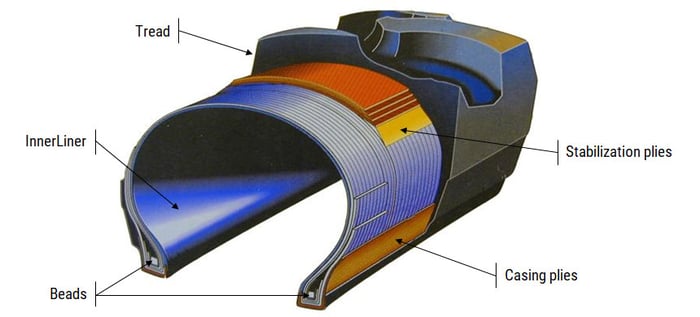
The more flexible sidewalls therefore work independently to the tread which is strengthened.
The diagonal structure is composed of an assembly of criss-crossing plies which form a thick layer which is sensitive to heating and less flexible than the radial structure.
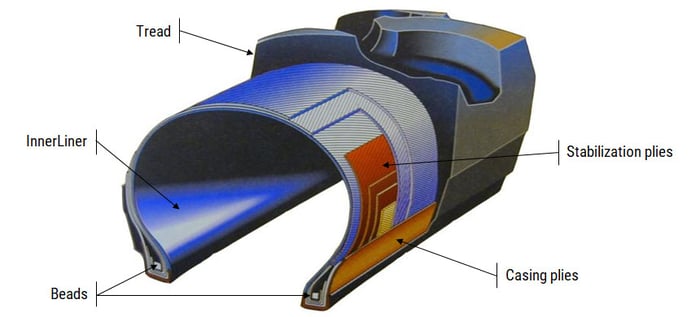
On the diagonal tyre, the sidewalls and the vertex are part of the same section, they are mutually dependent.
There is also a clear difference in the distribution of pressure on the soil:
There are three main categories of farming tyres for Radial structures:
Each tyre is designed to carry a maximum load defined by the manufacturer.
Before buying a farming tyre, it is wise to be aware of the weight of your equipment to avoid any problems down the line. You can find the load index written as a code on the sidewall.
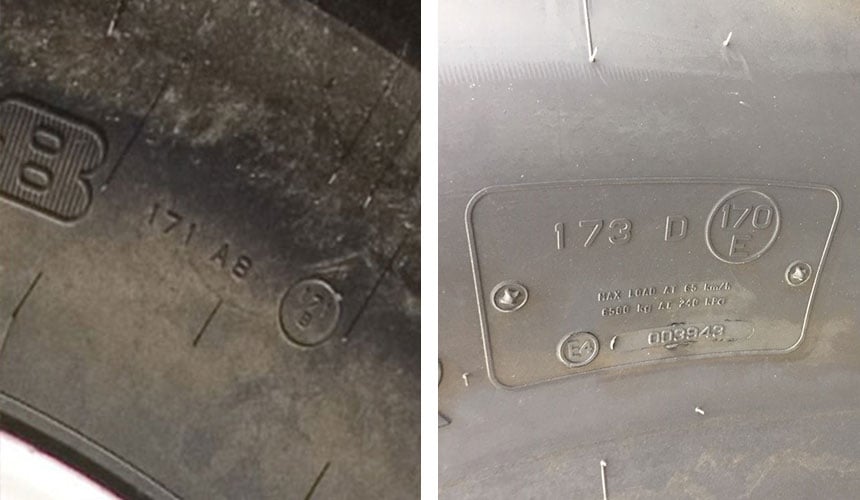
This is a reference value of the load that a tyre can carry, in relation to a standard pressure of 1.6 bar and a given speed.
In general the load and speed indexes provided in the different tables are based on a basic pressure of 1.6 bar.
| L.I. | Kg in weight |
|---|---|
| 100 | 800 kg |
| 101 | 825 kg |
| 102 | 850 kg |
| 103 | 875 kg |
| 104 | 900 kg |
| 105 | 925 kg |
| 106 | 950 kg |
| 107 | 975 kg |
| 108 | 1,000 kg |
| 109 | 1,030 kg |
| 110 | 1,060 kg |
| 111 | 1,090 kg |
| 112 | 1,120 kg |
| 113 | 1,150 kg |
| 114 | 1,180 kg |
| 115 | 1,215 kg |
| 116 | 1,250 kg |
| 117 | 1,285 kg |
| 118 | 1,320 kg |
| 119 | 1,360 kg |
| 120 | 1,400 kg |
| 121 | 1,450 kg |
| 122 | 1,500 kg |
| 123 | 1,550 kg |
| 124 | 1,600 kg |
| 125 | 1,650 kg |
| 126 | 1,700 kg |
| 127 | 1,750 kg |
| 128 | 1,800 kg |
| 129 | 1,850 kg |
| L.I. | Kg in weight |
|---|---|
| 130 | 1,900 kg |
| 131 | 1,950 kg |
| 132 | 2,000 kg |
| 133 | 2,060 kg |
| 134 | 2,120 kg |
| 135 | 2,180 kg |
| 136 | 2,240 kg |
| 137 | 2,300 kg |
| 138 | 2,360 kg |
| 139 | 2,430 kg |
| 140 | 2,500 kg |
| 141 | 2,575 kg |
| 142 | 2,650 kg |
| 143 | 2,725 kg |
| 144 | 2,800 kg |
| 145 | 2,900 kg |
| 146 | 3,000 kg |
| 147 | 3,075 kg |
| 148 | 3,150 kg |
| 149 | 3,250 kg |
| 150 | 3,350 kg |
| 151 | 3,450 kg |
| 152 | 3,550 kg |
| 153 | 3,650 kg |
| 154 | 3,750 kg |
| 155 | 3,875 kg |
| 156 | 4,000 kg |
| 157 | 4,125 kg |
| 158 | 4,250 kg |
| 159 | 4,375 kg |
| L.I. | Kg in weight |
|---|---|
| 160 | 4,500 kg |
| 161 | 4,625 kg |
| 162 | 4,750 kg |
| 163 | 4,875 kg |
| 164 | 5,000 kg |
| 165 | 5,150 kg |
| 166 | 5,300 kg |
| 167 | 5,450 kg |
| 168 | 5,600 kg |
| 169 | 5,800 kg |
| 170 | 6,000 kg |
| 171 | 6,150 kg |
| 172 | 6,300 kg |
| 173 | 6,500 kg |
| 174 | 6,700 kg |
| 175 | 6,900 kg |
| 176 | 7,100 kg |
| 177 | 7,300 kg |
| 178 | 7,500 kg |
| 179 | 7,750 kg |
| 180 | 8,000 kg |
| 181 | 8,250 kg |
| 182 | 8,500 kg |
| 183 | 8,750 kg |
| 184 | 9,000 kg |
| 185 | 9,250 kg |
| 186 | 9,500 kg |
| 187 | 9,750 kg |
| 188 | 10,000 kg |
| 189 | 10,300 kg |
As with the speed index, the load index enables you to work in the best conditions. These indications help you to use your tyres optimally and to get the very best from them.
By complying with the load index indicated on your farming tyre, you will increase its lifespan. However, if you don’t comply with the maximum load intended by the manufacturer your tyre will wear down more quickly.
The lifespan of a farming tyre depends on several parameters, among which speed is a major element.
The Speed Index is defined as the maximum speed authorised for the farming tyre when loaded. In concrete terms it is the ratio of the tyre’s load capacity to the tractor’s forward speed.
Like the measurements, the structure or the load index, the speed index is determined by the manufacturer. It is indicated on the tyre’s sidewall, just after the load index, in the form of an alphabetical code with or without a number:
In general, the load index and the speed index indicated in the different tables are based on a basic pressure of 1.6 bar.
| SPEED INDEX | SPEED in km/h |
|---|---|
| A1 | 5 km/h |
| A2 | 10 km/h |
| A3 | 15 km/h |
| A4 | 20 km/h |
| A5 | 25 km/h |
| A6 | 30 km/h |
| A7 | 35 km/h |
| A8 | 40 km/h |
| SPEED INDEX | SPEED in km/h |
|---|---|
| B | 50 km/h |
| C | 60 km/h |
| D | 65 km/h |
| E | 70 km/h |
| F | 80 km/h |
| G | 90 km/h |
Respecting the speed index indicated on your farming tyres will allow you to use them for longer, avoiding the costs of replacing them prematurely.
When you exceed the limits recommended by the manufacturer, you increase the risk of damaging the tyre’s rubber surface, as speed causes excessive heating, making the rubber more flexible and fragile, especially when driving on the road with a heavy load (as road surfaces are highly abrasive).
You can find the production date of your farm tyres easily. This detail will be important if you decide to choose used tyres. Some manufacturers also indicate the place of manufacturing, but this information is not mandatory.
This production date also triggers the five-year manufacturer's warranty. Some manufacturers can extend this warranty, as with Bridgestone Firestone agricultural tyres, to 10 years from the date of purchase of the tyres by the user (subject to presentation of proof, otherwise the 10-year warranty starts on the production date).
There are 52 weeks in the year. The week is indicated first (from 1 to 52) then the last two numbers of the year.
| 4899 = 48 and 99 which is the 48th week of 1999 |
| 2710 = 27 and 10 which is the 27th week of 2010 |
| 3214 = 32 and 14 which is the 32nd week of 2014 |
| 0220 = 02 and 20 which is the 2nd week of 2020 |
In old tyres, you could also find production date marking like “C 41 R”. First letter refers to month, figure in the middle refers to factory location code, and last letter refers to Year.
You can improve your tractor and your productivity simply by changing tyres. Increasing your tyre size or adapt tyre technology will enable you to use heavier equipments while protecting your soils even more.
Respecting the speed and load indexes will allow you to keep your tyres for much longer. Whatever the load, or the speed used, you need to adapt the tyre pressure to your use, based on load and pressure tables provided by each tyre manufacturers.
Most people who read this article have also read some of the following articles:

